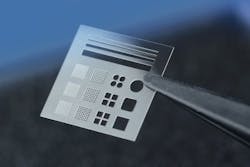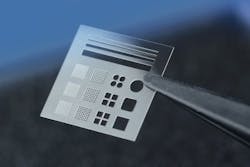Scientists are investigating how to use ultrashort-pulse (also known as ultrafast) lasers to etch microstructures into thin glass. There are possible applications in analytics (lab on a chip) and especially in electronics and the consumer sector.
Irradiating glass in a particular way with an ultrafast laser has the effect of making the glass up to a thousand times more sensitive to subsequent wet chemical etching. This means it is possible to guide a laser beam with a diameter of a few micrometers through a glass block and subsequently etch a fine tube through the volume of the glass. The method can be used to create the tiniest of holes, to etch complete microfluidic systems into glass, or to make cuts with extremely high surface quality.
Before this phenomenon can become an industrial processes, there are questions to be answered. Answering these is the aim of the German Federal Ministry of Education and Research (BMBF; Bonn, Germany)-funded Femto Digital Photonic Production joint research project. Since 2014, representatives at RWTH Aachen University (Aachen, Germany) and the Fraunhofer Institute for Laser Technology (ILT; Aachen, Germany) have been collaborating with six companies to study new phenomena that arise when processing transparent materials with ultrafast laser pulses. They have developed selective laser etching (SLE), which has been tested for several different types of glass materials, including quartz glass, sapphire, Borofloat 33, and Corning Willow. Etch selectivities of 1000:1 between laser-structured and unstructured areas were reached in Borofloat 33, and roughly 100:1 in Willow glass.
In the next phase of the project, experiments will be conducted at RWTH Aachen University, with complex simulations running in parallel at the Nonlinear Dynamics of Laser Manufacturing Processes Instruction and Research Department (NLD). The Chair for Technology of Optical Systems (TOS) will concentrate on optimizing the optics in the systems.
Researchers are collaborating with three laser source manufacturers (Amphos, Edgewave, and TRUMPF) and three system suppliers (4JET, LightFab, and Pulsar Photonics). Their goal is to develop multiple beam systems for large surface use, as well as smaller systems for micro-processing.
LightFab, a startup from RWTH Aachen University, uses SLE to produce 3D-precision parts made of quartz glass. This machine increases the productivity of the subtractive 3D printing of glass components for prototypes and series and, thanks to its high-speed modules, makes it possible to mass-produce components with the SLE process.
The project partners see a multitude of potential applications for the technique. For microfluidics, it not only produces channels in glass materials, but also nozzles and other micro-components. The technique also offers advantages in drilling and cutting processes. Etching allows tension-free material ablation, which is advantageous for instance when manufacturing interposer structures in semiconductor technology. It can produce structures measuring under 10μm.
For more information, please visit www.rwth-aachen.de and www.ilt.fraunhofer.de.


